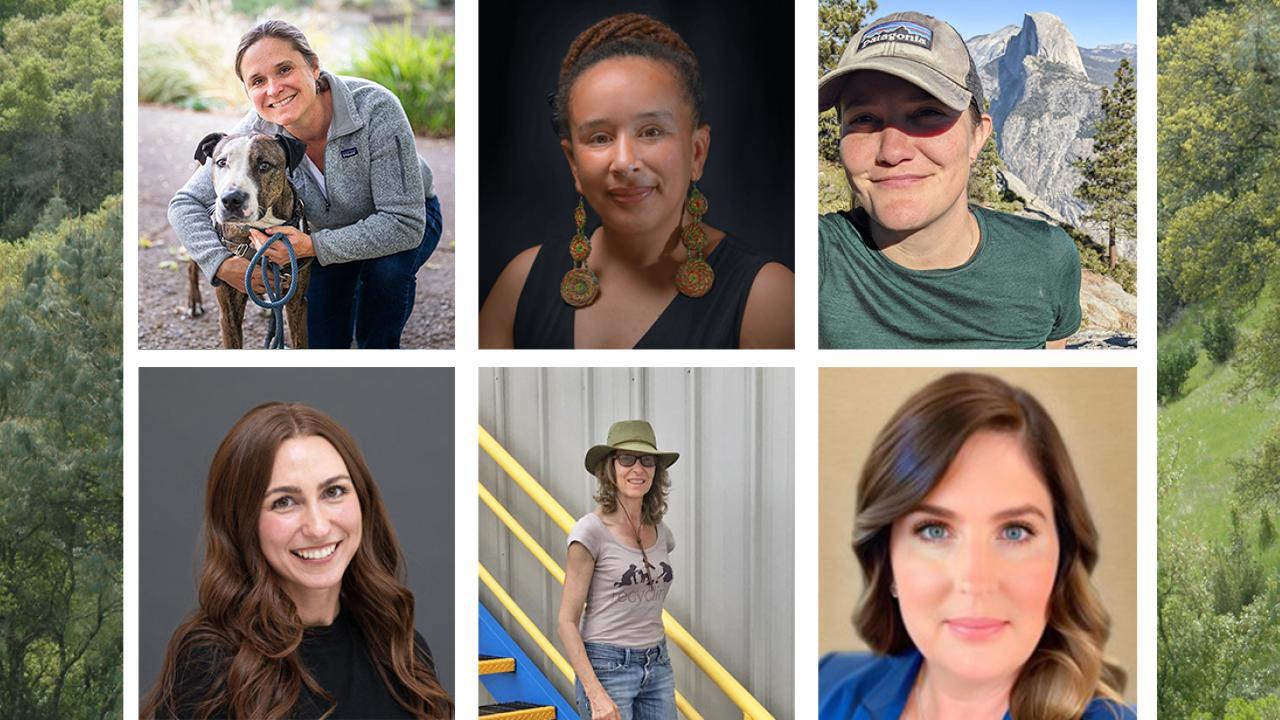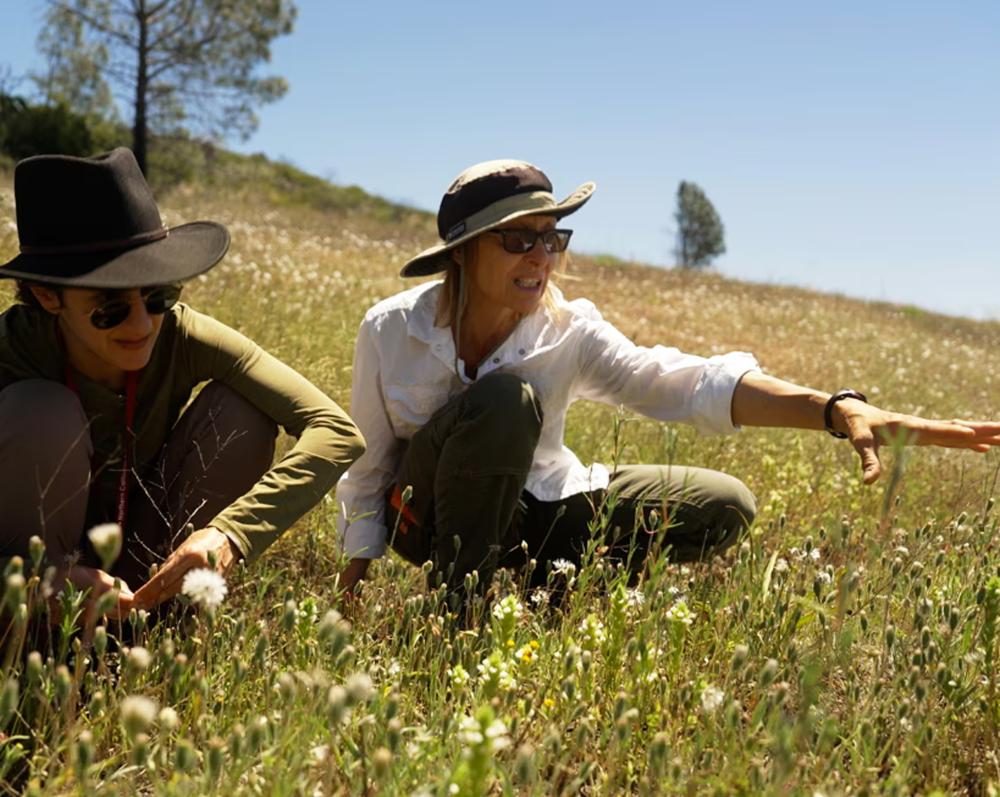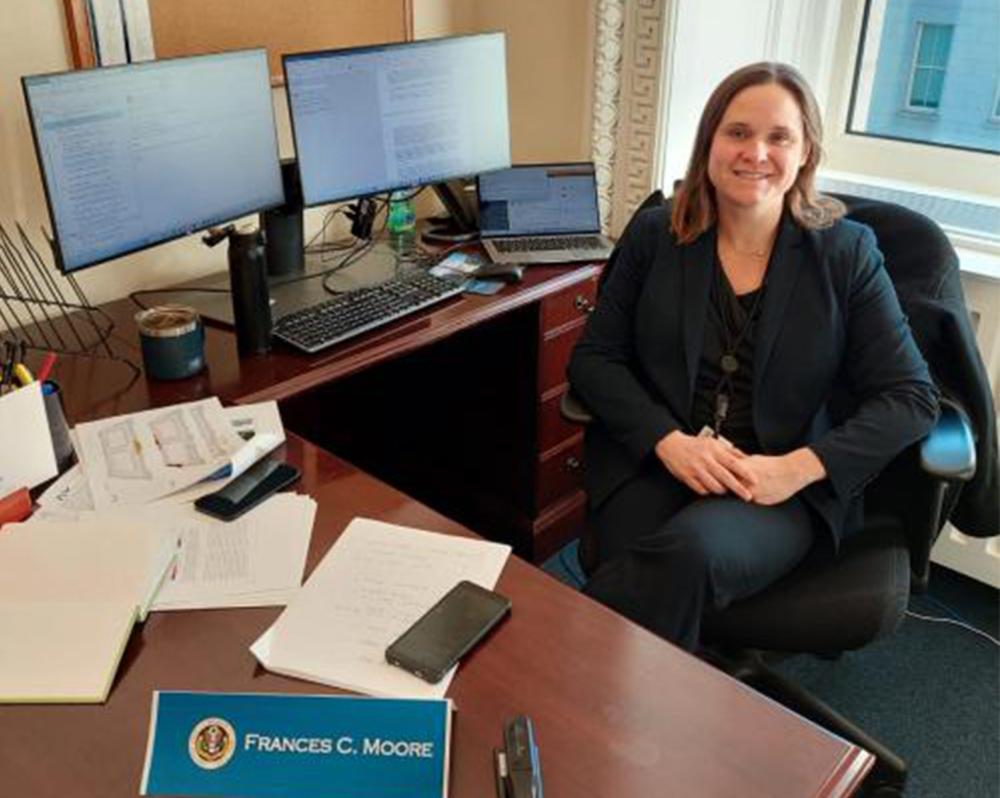
Women of the Institute of the Environment
Tell us about what your job entails?

Beth Rose Middleton-Manning: As Director of the Environmental and Climate Justice (ECJ) Hub my goal is to support interdisciplinary scholarships that address environmental and climate justice impacts - particularly across vulnerable communities. In addition to research, we support graduate students with mentoring and funding for environmental and climate justice research.
It’s been impactful to see students, particularly those in the hard sciences, think about how they can respond to environmental justice-related questions in their work. For example, we had a student whose advisor studied dust (the different sizes of particles, how they move in the atmosphere, and how they respond to heat). He applied this to how it affected agricultural laborers, the types of dust they were inhaling, and how this affected their health. We had another student whose research focused on groundwater and isotope tracing to discover where the contamination of groundwater was coming from. Through our Environmental Justice Fellowship and dialogue, she sharpened her analysis of thinking about how this was impacting the communities in the Southern Central Valley with really contaminated groundwater and how to better share the results with community members. With the latest round of ECJ scholars, there’s a lot of sharing, facilitating conversations between very different types of work in the environmental justice realm broadly.
Fran Moore: I am an Associate Professor in the Department of Environmental Science and Policy at UC Davis, working at the intersection of environmental economics and climate science. I also serve as a senior economist with the Council of Economic Advisors (CEA). A big component of my work is on research in climate change and what it means for the economy and human well-being. I do a lot of statistical and data analysis and computational modeling. Another big component as a professor is teaching. I teach undergraduates in Environmental Policy Analysis and Planning (EPAP) and I teach a data science class which is coding for students interested in environmental topics. I also teach Environmental Policy in the Environmental Policy Management (EPM) Master's Program.
Catherine Koehler: I am the Resident Director of the McLaughlin Reserve, which is one of 41 reserves across California, six of which are operated by UC Davis. As director, I oversee and personally engage in all operations of the Reserve. But what does that mean? The Reserve is a 7000+ acre property nested in tens of thousands of acres of public land, and it functions as an outdoor lab for University-level projects that need to occur in or address an aspect of the natural environment.
The Reserve has a bunkhouse and additional facilities that are available to people who are approved to use the Reserve, and our staff of three live on site. In order to support the research, education, and outreach mission of the University, we maintain all aspects of the Reserve. This includes not only helping researchers identify appropriate locations, species, and experimental protocols for their studies or co-teaching class field trips, but also managing the Reserve's ecosystems, conducting research, and maintaining all of the infrastructure including fences, roads, roofs, and plumbing!
Jennifer Smith: At the USDA California Climate Hub, I help translate science related to our climate, wildland health, and wildfires so it can inform and enable decisions by agency, government, and community leaders. This job takes a lot of different forms and can include facilitating conversations on complex topics, convening groups to align research interest and land management needs, developing trainings on data and tools available to support land management decisions, and creating synthetic science translation products like research briefs, factsheets, or videos.
Shruti Khanna: I work as a Senior Environmental Scientist with the California Department of Fish and Wildlife. I officially also come under the Interagency Ecological Program (IEP) which is a collaborative entity of 9 state and federal agencies. I'm part of a synthesis research group within IEP that is responsible for doing synthesis research in the Delta to aid in better management of the Delta ecosystem. Previous to this job, I did my PhD and postdoc under Dr. Ustin at the Center for Spatial Technologies and Remote Sensing (CSTARS) in the Delta region and I have been largely able to continue working with her to advance our knowledge of how invasive species have flourished in this region. She and I together have been successful in securing government funding for CSTARS to continue our research in the Delta into the behavior of aquatic floating and submerged invasive species.
Jessica Hicks: As the CAO, I am responsible for providing leadership and day-to-day management of the Institute’s financial and business operations, contracts and grants administration, human resources, information technology, and facility and space management. I also work closely with Institute leadership on strategic planning, and developing and carrying out long-term and short-term strategic business plans.
Jessica Penrose: In this role, I primarily manage external relations for the program. The Environmental Policy and Management (EPM) program relies on external partnerships to place students in Practicum Internships and to offer the Environmental Policy Clinic, a project-based learning course where students work in small teams with external organizations on environmental policy or management projects. I also work with the faculty chair and program coordinator to manage the day-to-day of the program, which includes advising, enrollment, hiring, admissions, budgets, curriculum, marketing and more!
What are you most proud of?

Catherine Koehler: I'm most proud of the "grassland restoration" that our small team has been very successful with, and which has attracted graduate students and faculty who seek ecosystems dominated by native species for their research projects. Our restoration efforts not only provide opportunities for research, but also support the tremendous biodiversity of the region and are shedding light on the resilience of native "grasslands", compared to those that are dominated by exotic invasive species, to climate change and associated environmental responses such as wildfire.
Beth Rose Middleton-Manning: I see a lot more funding and support for tribal initiatives and I think there’s a lot of opportunity to build on this momentum. We’d like to see some exciting projects move forward like land back and land stewardship partnerships. This last weekend a group of students and researchers held a conference with our partners, California Indian Legal Services and California Public Domain Allotment Association, for Native California allottees, hold parcels of trust land. Funding from the Climate Action Grant supports the initiative to serve that population. The students are beginning ecological surveys on the land working with the allottees, highlighting the conditions of certain species, and pairing that information with downscaled climate data. This work is collaborative and recognizes allottees' expertise as land stewards.
Fran Moore: I've been in Davis for about 7 years and seeing the success of the students that come through is really fantastic! Seeing the PhD students I've worked with closely graduate and go onto successful careers or the master's students who go into really exciting work in the policy world. Also contributing to policy. I mentioned I worked in D.C. for the 2022-2023 academic year at the Council of Economic Advisors and that was a huge privilege to contribute analysis on environment and climate topics. It was a really exciting time for climate policy in the U.S. as we'd just passed the Inflation Reduction Act. Continuing to engage with policy questions at the national level, is high up on my list of what I'm most proud of.
Jennifer Smith: I’m most proud of the USDA California Climate Hub’s reputation as an effective, reliable, and impactful partner. This reputation has made us in high demand and able to contribute to efforts that are important and worthwhile.
Shruti Khanna: Since 2004, CSTARS has been mapping invasive species in the Delta and currently has the only and longest-running dataset of invasive species distribution in this region. We have published this 21-year-long dataset online to an open-access website so other studies can use it. This long time series has also spurred multiple studies and gained insight into invasive species' behavior and management efficacy in the region. We are proud of all the work that has come out of our unique dataset through various alumni of CSTARS since the early 2000s. Because of this pioneering work, we recently secured funding from NASA for a four-year project to operationalize the mapping of aquatic vegetation in the Delta using Sentinel-2 satellite imagery.
Jessica Hicks: Our people! Our administrative team of staff and managers is top notch. They are collaborative and solutions-oriented, and they approach their roles with a high level of thoughtfulness and integrity.
Jessica Penrose: I am proud to be a first-generation college graduate and the first in my family to earn a graduate degree. I am also proud to be in this position! I never imagined myself working at a place like UC Davis with so many talented people.
What excites you about the position and program?

Jennifer Smith: Two things consistently excite me about my position and the program as a whole: first, the partners our program works with are leaders in a variety of fields, and are truly some of the most committed, thoughtful, and enjoyable people to work with; second, the amount and diversity of work and research happening related to climate, wildfire and land management is inspiring and gives me hope.
Beth Rose Middleton-Manning: We have collaborated with the Yurok Tribe on two environmental health projects. These address community concerns about possible environmental contaminant exposures. I think it is very important to be able to work in an interdisciplinary, collaborative way with community members to address daily concerns about environmental exposures.
Fran Moore: I would say that being a professor is great in that what you're doing changes from day to day. It's an interesting mix. Some days I'm working on a paper, sitting at my desk, and writing away. Other days I'm teaching, having office hours, and talking to students. Sometimes I'm presenting at conferences and thinking about ideas, research and questions with my academic colleagues. I like the variety of things you can do. It's great having a strong group of environmental faculty across UC Davis. I collaborate a lot across departments with everyone from scientists to ecologists.
Catherine Koehler: It is fantastic being able to interact with all of the people who conduct projects at the Reserve, and to watch them interact with each other at the field station. While each person comes to the Reserve with a personal agenda - it could be scientific research, artistic endeavors, a writing retreat, or something else - everyone is here because of the place. As they interact with each other, their own understanding of the place broadens as they start to see the place through the interests and perspectives of the people around them. For me, this place-based learning is one of the most important aspects of the Reserve; personal experiences become shared experiences, and everyone is enriched by the shared knowledge. My own appreciation and understanding of the fantastic natural environment of the Reserve continues to grow with each new project that is started, and through discoveries made through patient long-term studies. And I get to share that wealth of perspective and knowledge with the people who use the Reserve, which broadens their perspective and often informs their work. It's really quite wonderful.
Shruti Khanna: At CDFW, we don't have access to the same server computing resources and memory space, or the same software as in CSTARS. Working closely with Dr. Ustin and continuing our close collaboration under the umbrella of IE have enabled me to continue to build the body of work I started during my PhD years. Without this capability of continuing to work at CSTARS, I would be unable to do my job, period.
Jessica Hicks: The research. I’ve spent most of my career at UC Davis in roles that support the University’s research enterprise and I always find the research exciting. The research that’s happening at the Institute is diverse and multidisciplinary and it’s bringing together real-world solutions that will have real impacts on our everyday lives and on the planet.
Jessica Penrose: I find it exciting that there is room to grow in both my position and the program. It's been rewarding watching the program grow from 7 students in its first year to around 60 students per year. We have big ideas on how to continue to grow the program and its offerings, and I hope that I'll be around to see some of them through. Each year, it is exciting to meet all of the new students and learn from their experiences and expertise!
What do you see as the biggest new opportunity on the horizon?

Fran Moore: I've become interested in working on insurance questions. That's a research area that I'm building up right now, there are a lot of challenges. California is one case and point, but it's not just California. I see this as an opportunity with two dimensions. There's a lot of exciting research areas and academic questions to be answered. Also disaster response and management, and insurance is a bit of a mess in the country at the moment. So to some extent having these really clear problems presents an opportunity to think about how can we do this better in the future. That's something I'm interested in at the moment and have written background pieces on.
Beth Rose Middleton-Manning - Seeing the work be useful for our collaborators and seeing people move it forward. At the August CA Public Domain Allotments conference, people were interested, engaged, and wanted to work together. They’re happy to see attention being paid to allotments. They’re interested in the information and the opportunities to do practical things like obtaining data and status reports on their lands. With the Yurok Tribe, it’s been useful for partners to review exposure and contaminant information. I’m looking forward to hearing their reactions to learn where we should go next with these projects. With the dam removal work, I worked with collaborators in Alaska that are engaged in a political process to restore a a river. I wrote a paper on this and I'm hopeful that it will be supportive of the group navigating the politics. Working with partners to address daily, lived issues is what excites me most.
Catherine Koehler - The McLaughlin Reserve is in an area that consists of complex geology that supports a mosaic of plant communities and remarkably high biodiversity, which has been central to much of the scientific research in evolutionary ecology and genetics that has been conducted at the Reserve. In one area, on one Reserve, people can ask a range of ecological questions that usually require extensive travel between scattered research areas, all because this one location offers such a large variety of ecological conditions in one spot. As we now seek to understand how climate change is going to impact our natural environment, which in turn impacts human populations and aspirations, there is an emergent value of the Reserve as a place where we can study the outcomes of actions we take to manage natural lands for resilience to climate change across a range of ecological conditions. The land's complexity makes it an extremely appropriate place to understand the unique approaches needed to manage each ecosystem (grasslands, prairie, oak woodland, shrubland, and their associated rare species) and the consequences of different actions that are taken for management. It's a place where we not only seek to understand the natural world, but we can seek nature-based solutions to some of the most pressing problems of our time.
Jennifer Smith - Though I’m not sure this is a “new” opportunity, a highly relevant and generally underemphasized opportunity is the need to increase connection, understanding, and alignment among the issues of (and groups interested in) conserving aquatic species, water security, forest health, and beneficial fire.
Shruti Khanna - As our data time series lengthens, we are able to do more exciting and cutting-edge research by integrating invasive species distribution maps with other environmental variables and creating species distribution models for the targeted invasive species. This is going to allow us to start modeling some future scenarios including planned restoration projects, management actions, and changes expected with climate change. I'm excited to see what other mysteries of invasive species we are able to unlock that can help in managing these aggressive invasives and improving the conditions for endangered native fishes in the Delta.
Jessica Hicks - New leadership always brings with it new opportunities, and with a new Vice Chancellor for Research, we have a chance to partner with him on new initiatives and opportunities for the Institute.
Jessica Penrose - This is tough! There are a lot of growth opportunities for this program that we are considering, and they are all very exciting and would bring new opportunities to future students.